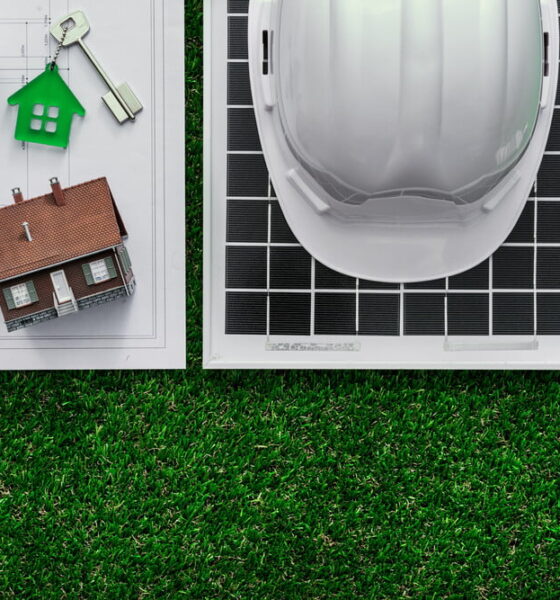

Features
Green Leases: The Starting Point for Building Improvement
For most businesses, buildings account for a significant proportion of the carbon and energy used. The World Green Building Council estimates that construction and buildings account for 39% of the global carbon footprint. If you understand the role of buildings in climate change, then you can appreciate the need for solutions to lower their carbon footprint.
In addition to the activities within the building that consume energy and water and generate waste, businesses will need to increasingly consider the emissions from staff commuting and from the use of materials in fit-out, alteration and refurbishment. They may also need to consider the need for retrofitting buildings to lower their carbon footprints. A net-zero plan is also likely to consider embedded carbon within the building’s structure and the business’ share of that over the total lifetime of the building.
But businesses face two intertwined issues when developing their strategy to reduce emissions from buildings.
The challenge for tenants
A significant proportion of the building stock that will exist for the next hundred years has already been built. This reduces our ability to erect new buildings that have a lower environmental footprint. Carbon reduction targets are unlikely to be met simply by building or relocating to new buildings. Existing buildings, particularly those constructed in the last century, will need to be improved.
Most businesses are tenants, likely to be occupiers for a proportionally short period of the building’s lifetime and possibly renting only a proportion of the total area of the building.
Not only are improvements that will have the most significant impact, usually those relating to the infrastructure, expensive, but their benefit is likely to be shared across the whole building and last for a long time.
Additionally, tenants are unlikely to have the legal rights to carry out the changes that create the largest impact. Typically, tenants have few rights to change a property. A fit-out of the interior may be possible, but structural changes are usually the responsibility of the owner. A tenant may not even be able to change an energy provider or switch to a greener energy tariff.
However, the responsibility for the carbon accounting and reduction lies with the tenant, so making sure that both the costs and the benefits are shared correctly between the business, other tenants and the landlord is key. The owner may need to bear the responsibility of making changes to make the building eco-friendly.
Changing the balance of power
In order to be able to make the changes that allow businesses to reach net-zero emissions, the power and co-operation between landlords and tenants need to shift. Key terms in leases will remain but be supplemented by ‘green’ lease terms. A lease may be renegotiated entirely, or the owner and occupiers may use a memorandum of understanding alongside the lease. Unlike a lease, an MoU is not legally binding but can be modified more easily as strategies are developed.
Benefit for the landlord
Although landlords are likely to be expected to meet some of the costs of improvement, some of the costs can be borne by the tenant, particularly those relating to developing and implementing strategy. Additionally, the value of properties that are neither improved nor let on green leases is likely to diminish as tenants choose to occupy those that allow their businesses to reduce emissions. So the benefit to the landlord in co-operation is one of maintaining and possibly increasing capital value.
The Better Buildings Partnership is championing green leases and has produced a comprehensive toolkit to help owners and occupiers to engage with each other in order to develop practical ways in which buildings can be made to be more sustainable.
Green lease terms
Green lease terms generally commit the landlord and the tenant to co-operation and communication; data sharing and metering; rights to carry out work; and rent reviews that recognise the tenant’s contribution to the increased value of the building.
Co-operation and communication
The success of green lease terms relies on the parties’ willingness to work together, as much as it does on legal obligations.
A statement that states the parties’ intentions and shared aims to improve the environmental performance of the premises is not legally binding but rather a building block for the framework in which the parties can communicate and raise issues.
The substance is in a commitment to form a management group to allow discussion. This may be as formal as required.
Data sharing and metering
Without data, it is impossible to plan strategies for reduction. Good data requires good measurement.
A building may not have separate metering for each tenant and the supply might be controlled entirely by the landlord. Even where sub-meters are in place, they may not be sophisticated enough to give the tenant the data required.
Generally, the landlord will want to retain control over meters where they are situated in common parts of the building. It may want to be able to recharge the cost of improvements to the tenant. The tenant may need rights to make changes or access parts of the building to carry out work. Green lease terms may give such rights, but they also might provide the process through which they are later granted.
Rights to carry out work
Although it is in the interests of both the landlord and the tenant to improve the environmental performance of the building, because this can be done in many ways, the parties may not agree as to what should be carried out and when.
Terms should cover the situations where the landlord wishes to carry out work sooner than the tenant wishes, or those that are less important to the tenant (such as to common areas that proportionally benefit the tenant less, but which could seriously disrupt the tenant’s business while being carried out). They should balance those additional rights with ones that protect the tenant, particularly from the risks that the landlord’s works reduce the EPC rating of the areas that the tenant rents. Lastly, the tenant may want freedom to carry out alterations with fewer permissions than currently required.
Rent reviews
Rent reviews tend to look at current market rates and adjust rents upwards if rates have increased. They can be unsophisticated.
A green lease can state that rent reviews should take into account the tenant’s contributions to the improvement of the building, and recognise that in addition to the rent, some of the cost of renting may be that the tenant is required to spend on infrastructure that raises the value of the building after the lease expires.
Likewise, the landlord may undertake works that reduce the tenant’s operational costs. For example, a more efficient HVAC system is likely to reduce heating costs. If the cost of installing such a system is not recoverable from the tenant under the lease, increasing the rent at a review may provide both the means and the willingness of the landlord to invest in such changes.
Green leases are the enabler, not the solution
A business is unlikely to reach a net-zero goal simply by changing legal agreements. But without changing the legal rights and responsibilities, the efforts that will make the difference are unlikely to be able to be undertaken.
Leases are therefore something that should be considered early on when developing a sustainability strategy.


 Environment10 months ago
Environment10 months agoAre Polymer Banknotes: an Eco-Friendly Trend or a Groundswell?

 Environment11 months ago
Environment11 months agoEco-Friendly Home Improvements: Top 7 Upgrades for 2025

 Features9 months ago
Features9 months agoEco-Friendly Cryptocurrencies: Sustainable Investment Choices

 Features10 months ago
Features10 months agoEco-Friendly Crypto Traders Must Find the Right Exchange





























